Final Report for GW14-011
Project Information
With the recognition that agro-ecosystems are highly interconnected and multifaceted, a major challenge facing agriculture is preserving and improving honey bee health. Stress associated with transportation, nutritional consequences, various diseases and pests have all been recognized as potential factors in honey bee decline. However, intracolony genetic diversity has been shown to result in increased colony survival and productivity through various mechanisms. At the population level, genetic diversity serves as the raw material for selective breeding in agriculturally important plants and animals, including the honey bee.
Honey bees are native to the Old World and only a small fraction of this original population was ever introduced into the U.S. The importation and founder events associated with the establishment of honey bees in North America represent a series of genetic bottlenecks that have limited the diversity of introduced honey bee populations. These bottlenecks include: the limited size of founding populations, parasitic mite reduction of U.S. honey bee populations (managed and feral), and ongoing production of queens from a small number of queen mothers.
The goal of this project was two-fold: perform a comprehensive analysis of genetic diversity of Old and New World honey bee populations, and secondly, educate beekeepers (from backyard beekeepers to large-scale commercial operations, and major queen producers), through a variety of outreach tools, regarding the benefits of genetic diversity in honey bee populations. Our results indicate that although U.S. honey bee populations are less genetically diverse than their Old World progenitors, losses in alleles through time were mitigated by the incorporation of Old World germplasm, thereby increasing overall allelic richness of U.S. queen producer populations.
Taken together, these results indicate the Old World could not only serve as a genetic reservoir to access additional genetic diversity, but could allow for the long-term adaptability of honey bees by providing a broader genetic basis from which to select and breed for more locally adapted bees with improved apicultural traits.
Introduction
Honey bees are at the center of modern agricultural production, contributing 14.6 billion dollars annually in pollination services alone (Morse and Calderone, 2000). As a single crop, almonds represent $2 billion annual industry in California and production relies almost exclusively on honey bee pollination. As such, nearly half of all managed colonies must be seasonally transported across the country to meet the demands required for successful pollination. Under natural conditions, honey bees are highly polylectic and visit a variety of floral types. Shifts in agricultural practice toward ever larger monocultures, sequential placement on crops, and reduced alternative foraging opportunities, however, has led to major seasonal dietary limitations for the honey bee.
Although honey bees are now distributed worldwide, the species (comprised of 28 recognized subspecies) is endemic to the Old World (Meixner et al., 2011; Sheppard and Meixner, 2003; Sheppard et al., 1997). A small number of these subspecies were imported to North America, primarily between 1622 and 1922, and formed the genetic underpinning for current U.S. honey bee populations (Sheppard, 1989a).
Genetic diversity of the honey bee at the colony level has been shown to play a key role in colony fitness and overall health. Increased colony diversity is associated with lower disease intensity, increased disease resistance, greater workforce productivity, and thermoregulation stability (Mattila and Seeley 2010; Hughes et al., 2008; Seeley and Tarpy, 2007; Jones et al., 2004; Tarpy 2003). Unfortunately, the importation and founder events associated with the establishment of honey bees in the U.S., coupled with the current queen production methods, represent a series of genetic bottlenecks that have reduced honey bee genetic diversity at the population level. These bottlenecks include: the limited size of founding populations introduced into North America; mite-mediated reduction of North American honey bee populations and elimination of feral sources of genetic variation; and annual commercial production of queens from a small number of queen mothers (Schiff and Sheppard, 1995; Delaney et al., 2009; Seeley, 2007). The U.S. Honey Bee Act (1922) established restrictions on the importation of honey bees into the United States, resulting in over 90 years of domestic bee breeding without the incorporation of significant new genetic material. Only with the exception by the United States Department of Agriculture (USDA) can honey bees be imported for experimental or scientific purposes (Public Law 94-319).
Recent improvements in the long-term storage and cryopreservation of honey bee semen has led to the successful instrumental insemination of honey bee queens. As permitted by APHIS and USDA, the Sheppard Lab has been involved in the collection of Old World germplasm since 2008, and its experimental use in breeding has been underway over the last few years. The suplementation of Old World cryopreserved germplasm in a select few U.S. queen producers is currently underway as a means to increase genitive diversity of their populations.
Microsatellites can be used to assess genetic diversity within and among honey bee populations (Delaney et al., 2009; Bourgeois et al., 2008; Shaibi et al., 2008; Solignac et al., 2003). Based on previous research findings, it is hypothesized that honey bees in the New World will be less genetically divers than Old World populations, and thus, could provide additional genetic diversity for long-term sustainable U.S. honey bee breeding efforts.
To perform a comprehensive analysis of the genetic diversity of Old and New World honey bee populations and develop an outreach plan to communicate these findings, three main objectives were addressed over the course of this project.
Objective 1. Assess the genetic diversity of honey bee populations from a representative sampling of Old World honey bee subspecies sampled from their native range and compare this to “strains” currently available in the United States:
The genetic diversity of three Old World subspecies (A. m. ligustica, A. m. carnica, and A. m. caucasica) originating from Italy, Slovenia, Georgia, and Turkey were assessed using microsatellite analysis. These subspecies are a realistic representation of what was originally brought to and established here in the U.S. To analyze U.S. populations, honey bee samples from major commercial queen production operations in California and Hawaii were assessed in addition to several feral populations.
Objective 2. Assess the genetic diversity of New World honey bees spanning three decades and following recent germplasm releases on commercially available queens:
Honey bee samples from several major commercial queen production operations in California and Hawaii were sampled in 2015. Previous estimates of genetic diversity in commercial stock by Delaney et al. (2009) used samples collected from 1993-1994 and 2004-2005. Specifically, queen producer populations sampled in 2015 (QP 2015) will be compared to those used by Delaney et al. (2009) in 2004 (QP 2004) and 1994 (QP 1994) to determine if there has been a change in allele frequency over time. Additionally, as permitted by APHIS, several California commercial queen producers have incorporated Old World germplasm into their breeding programs in recent years. Therefore, samples from 2015 include both queen producers who have incorporated Old World germplasm into their breeding programs compared to those that have not. These two populations will also be compared as a means to evaluate the impact of germplasm releases on genetic diversity and sustainable bee breeding.
Objective 3. Bring awareness to the genetic diversity of honey bees and its importance in sustainable agriculture and beekeeping practices:
We will distribute our findings through our extension program, local and national meetings, WSU workshops and beekeeping short courses, and publication via peer-reviewed journals and interviews and fact sheets.
Cooperators
Research
The evaluation of differences in genetic diversity among the source and introduced populations was to be used to make recommendations to beekeepers and queen producers to maximize genetic variation in the stocks from which they make their selections. Further, due to the negative consequences of inbreeding, our results will also provide a means for the queen producers to assess the genetic underpinnings of their particular stocks.
Worker samples. All Old World samples were obtained from prior collecting trips and stored in the Sheppard lab. Samples from each queen mother colony from California and Hawaii commercial queen breeders represent those that are currently sold to beekeepers across the United States. All California and Hawaii samples were stored in 95% ethyl alcohol and Old World samples were stored at -80°C. After communicating this proposed research to various beekeeping groups, several citizen scientists sent me a number of feral samples of honey bees with collection date and locality information representing sample sites from Georgia, Utah, Nevada, Arizona, and California.
Molecular analysis. DNA was extracted from the hind leg of a single worker from each queen-mother colony and placed into 150 μl of 10% Chelex® and 5 μl of 10% proteinase K solution. PCR was used to amplify several loci from the extracted DNA, using ten well-established microsatellites (Delaney et al., 2009; Bourgeois et al., 2008; Shaibi et al., 2008; Solignac et al., 2003). Amplification of the DNA was be done by adding varying concentrations of reaction buffer, Taq polymerase, dNTPs, fluorescent dye-labeled primer, and MgCl2. Microsatellite fragment size was scored using GeneMapper software (version 5.0).
Statistical analysis. Allele frequencies for each population were summarized in GENETIX version 4.05 (Belkhir et al., 2004).. Observed allelic richness (ag) and unique alleles in a given population were simply tallied using HP-RARE v. June-6-2006 (Kalinowski, 2005). Mean number of alleles per locus and range of alleles was summarized using GENEPOP web version 4.2 (Raymond and Rousset, 1995). Paired t-tests for the number of alleles at each locus for each population were used to determine significant losses or gains in allelic diversity between any two populations compared.
Maintaining genetic diversity is critical towards the development of stronger, healthier, disease and mite resistant honey bees. Current methods of in-hive treatments and pesticide applications are costly and futile given the adaptive nature of biological systems. This research is the first of its kind to assess genetic diversity of honey bee populations on such a large scale. Additionally, to date no research has been conducted on the assessment of U.S. honey bee populations since wide spread reports of CCD and could therefore become an increasingly valuable resource for future research.
Objective 1. Assess the genetic diversity of honey bee populations from a representative sampling of Old World honey bee subspecies sampled from their native range and compare this to “strains” currently available in the United States:
Based on microsatellite data and principle component analysis (PCA), results indicated that Old World subspecies (A. m. ligustica, A. m. carnica, and A. m. caucasica) were more genetically diverse than their New World counterparts. Although Old World subspecies formed three clearly distinct groups, spanning a wide range, not only did New World strains not align with any one of the Old World subspecies, they were less genetically diverse than Old World populations. However, although there were fewer samples collected to represent feral populations within the U.S., based on principle component analysis, this group was more genetically diverse than the commercial queen producers strains here in the U.S., yet did not align with any Old World subspecies in particular.
Additionally, Old World subspecies contained almost half (47%) of all unique alleles found. The remainder were distributed among the U.S. commercial strains (15%) and New World feral populations (38%). Unfortunately, because feral populations have been largely reduced due to Varroa destructor, U.S. commercial queen producer strains are a more realistic predictor of the genetic diversity found within the U.S. When New World feral populations were removed, there were 179 different alleles found among the populations. Of the 179 alleles, 97 were unique to either to one population or another. Of those 97 unique alleles, 89% were unique to the Old World, while only 11% were unique to the New World population.
Taken together, these results suggest that although U.S. honey bees are lacking in genetic diversity, Old World progenitor subspecies could provide additional genetic diversity for U.S. honey bee breeding efforts.
Objective 2. Assess the genetic diversity of New World honey bees spanning three decades and following recent germplasm releases on commercially available queens:
When sampling queen producers in the U.S., Delaney et al. (2009) reported finding total of 128 alleles in 1994 and then 92 of those same alleles again in 2004. This study was concerned with determining what proportion of those original 92 alleles still remained in the CA and HI breeding population in 2015. Results indicate that queen producers not incorporating Old World germplasm into their breeding programs retained 72 of the original 92, a loss of 20 alleles. However, those queen producers that are actively incorporating Old World germplasm into their breeding programs retained 80 of the original 92, a loss of only 12 alleles.
To account for variations in sample size of the populations assessed, rarefaction with HP-RARE was employed for all allele counts (Kalinowski, 2005). There were a total of 168 alleles present in queen producer populations sampled in 2015 (QP 2015). These results indicate that there was a significant gain in alleles when comparing queen producers from 2015 to those sampled in 1994 (p<0.05) and in 2004 (p<0.01). However, if queen producers using Old World germplasm are removed from the 2015 sample set, queen producers not incorporating Old World germplasm into their breeding program had significantly fewer alleles than previous years samples. Overall allelic richness of commercial queen producers from 1994 to 2015 is summarized in. These results suggest that the incorporation of Old World germplasm mitigated the loss of alleles through time and, in fact, increased overall allelic richness by incorporating novel genetic material into U.S. commercial queen production operations.
Objective 3. Bring awareness to the genetic diversity of honey bees and its importance in sustainable agriculture and beekeeping practices:
Results for Objective 3 are discussed at length in the Publication and Outreach section below.
Research Outcomes
Education and Outreach
Participation Summary:
We will distribute our findings through our extension program, local and national meetings, WSU workshops and beekeeping short courses, and publication via peer-reviewed journals and interviews and fact sheets.
Presentations:
- Upon receiving this grant, since October, 2013, I have since given a total of 27 presentations/talks regarding the importance of this research and bees in general. These talks ranged from local beekeeping associations to national conferences and stakeholders meetings. Additionally, through these personal communications, interviews, and presentations, citizen scientists were not only interested in the research but had personally collected feral honey bee samples with pertinent information like collection date, location (sometime with GPS coordinates), pictures (Figure 1), and any background knowledge they had regarding the feral colony from which they collected. All talks are listed below in the Publication and Outreach section.
Figure 1. Pictures of two feral honey bee colonies on a single cliff in Wenatchee, WA (2016) that according to the photographer, have been in existence prior to 2001 (Photos courtesy: Chris Church, 2016).
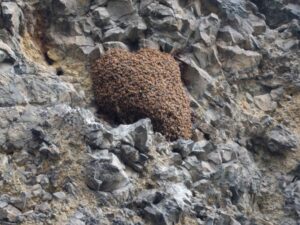
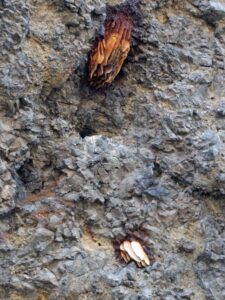
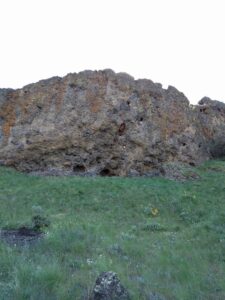
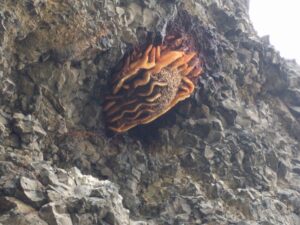
Education through short-courses:
- Washington State University holds an annual beekeeping and queen rearing short course for novice to veteran beekeepers. We frequently have attendees from across Washington and surrounding states. During these courses, students attend in-class sections where they are presented information regarding research our lab is currently conducting. During this time, the importance of genetic diversity in honey bee populations is discussed with ongoing updates of the present study. Beekeepers are shown the benefits of diversity on honey bees and ways in which they can increase diversity in their stock.
Publications:
- Plans to publish these findings in peer reviewed journals are underway. Specifically, we are looking into publishing in Apidologie, Genetics, and Journal of Economic Entomology. In addition, popular press articles regarding this research will be submitted to beekeeping trade journals such as American Bee Journal and Bee Culture. Proposed manuscript titles are as follows:
Taylor, M.A. and Sheppard, W.S. Genetic characterization of United States honey bee (Apis mellifera) breeding populations and Old World source populations. (manuscript to be submitted).
Taylor, M.A. and Sheppard, W.S. Genetic Diversity of New World honey bees (Apis mellifera) through time following germplasm releases. (manuscript to be submitted)
- I was also interviewed by Russ Walsh from the Pacific Northwest Inlander. The published article covered the current research in the Sheppard lab inclusing a section on my research specifically. It highlighted the importance of this type of research and some preliminary findings.
http://www.inlander.com/spokane/a-better-bee/Content?oid=2719898
- Plans to build a new centralized bee research facility at Washington State University are currently underway. In addition to having a state-of-the-art research facility, this will be the world’s first honey bee germplasm repository and will contain germplasm from Old World honey bees.
http://pcbeekeepers.org/wp-content/uploads/2015/04/Honey-Bee-White-Paper.pdf
Our lab recently gave tours of our current research facilities to a several stakeholder and private donors. During these meetings/guided tours, not only was the significance of this research discussed at length highlighting the pivotal role genetic diversity plays in the health of honey bees, but this time was also used to increase the awareness of bee research in general. Even our university’s provost wore a “bee beard” to support our lab’s research and raise awareness of the importance of bee research in general.
“WSU provost wears bees to raise awareness of bees and research”:
- Infographics are a great way to communicate information to stakeholders and the public (Figure 2). Below is a link to a webpage outlining the importance of bees, factors affecting honey bee health (a lack of genetic diversity outlined as a likely culprit in CCD), and current research underway:
http://cahnrs.wsu.edu/blog/2015/01/wsus-green-times-all-about-bees-and-more/
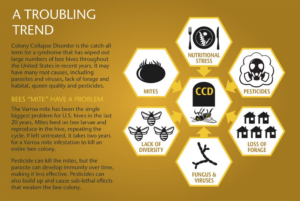 Figure 2. Data sources for all three infographics: Washington State Department of Agriculture, Washington State Beekeeper’s Association, and Washington State University Dept. of Entomology. Written by Seth Truscott, WSU. Illustrations by Gerald Steffen, WSU.
Figure 2. Data sources for all three infographics: Washington State Department of Agriculture, Washington State Beekeeper’s Association, and Washington State University Dept. of Entomology. Written by Seth Truscott, WSU. Illustrations by Gerald Steffen, WSU.
- The Washington State Beekeepers’ Association works closely with WSU and aside from awarding funding for this current study’s research, we provide the association with updates about our research and they in turn post a brief overview of what research is currently underway in our lab:
https://wasba.org/wa4bees_research/
Presentations and Invited Talks:
Taylor, M.A. and Sheppard, W.S. 2016. North Central Washington Beekeepers Association: Pollinator Symposium (Wenatchee, WA).
Taylor, M.A. and Sheppard, W.S. 2016. Central Velley Beekeepers’ Association (Clarkston, WA).
Taylor, M.A. and Sheppard, W.S. 2016. Northwest District Beekeepers (Snohomish, WA).
Taylor, M.A. and Sheppard, W.S. 2016. Yakima Master Gardener: Pollinators and Beneficial Insects Symposium (Yakima, WA).
Taylor, M.A. and Sheppard, W.S. 2016. Yakima Master Gardener: Honey Bee Biology and Genetics (Yakima, WA).
Taylor, M.A. and Sheppard, W.S. 2015. Mid-Columbia Beekeepers’ Association (Kennewick, WA).
Taylor, M.A. 2015. University of Idaho: Science Saturdays in the Arboretum (Moscow, ID).
Taylor, M.A. and Sheppard, W.S. 2015. Palouse beekeepers’ Meeting (Moscow, ID).
Taylor, M.A. 2015. Idaho Family Forest Landowners and Managers Conference (Moscow, ID).
Taylor, M.A. and Sheppard, W.S. 2015. Olympia Beekeepers’ Association (Olympia, WA).
Taylor, M.A. and Sheppard, W.S. 2014. Central Ontario Beekeepers’ Association (Cavan, ON, Canada).
Taylor, M.A. 2014. Pesticide Recertification Training Program (Pasco, WA).
Taylor, M.A. and Sheppard, W.S. 2014. California State Beekeepers’ Association Annual Meeting (Valencia, CA).
Taylor, M.A. and Sheppard, W.S. 2014. Entomological Society of America National Annual Meeting (Portland, OR).
Taylor, M.A. and Sheppard, W.S. 2014. Oregon State Beekeepers’ Association Annual Meeting (Seaside, OR).
Taylor, M.A. 2014. WSU Intro Beekeeping Course (Pullman, WA).
Taylor, M.A. and Sheppard, W.S. 2014. NCW Beekeepers’ Association (Wenatchee, WA).
Taylor, M.A. and Sheppard, W.S. 2014. West Plains Beekeepers’ Association (Medical Lake, WA).
Taylor, M.A. 2014. Kinnikinnick Native Plant Society (Sandpoint, ID).
Taylor, M.A. and Sheppard, W.S. 2014. Entomological Society of America Pacific Branch Annual Meeting (Tuscon, AZ).
Taylor, M.A. 2014. University of Idaho Extension: Turf, Tree, and Landscape Conference (Post Falls, ID).
Taylor, M.A. and Sheppard, W.S. 2014. West Sound Beekeepers’ Association (Silverdale, WA).
Taylor, M.A. and Sheppard, W.S. 2014. North American Beekeeping Conference (Baton Rouge, LA).
Taylor, M.A. and Sheppard, W.S. 2013. Central Ontario Beekeepers’ Association (Cavan, ON, Canada).
Taylor, M.A. 2013. University of Idaho Extension: Current Topics in Forest Health (Coeur d’Alene, ID).
Taylor, M.A. 2013. University of Idaho Extension: Procrastinator’s Pesticide Workshop (Bonners Ferry, ID).
Taylor, M.A. and Sheppard, W.S. 2013. Washington State Beekeepers’ Association (Federal Way, WA).